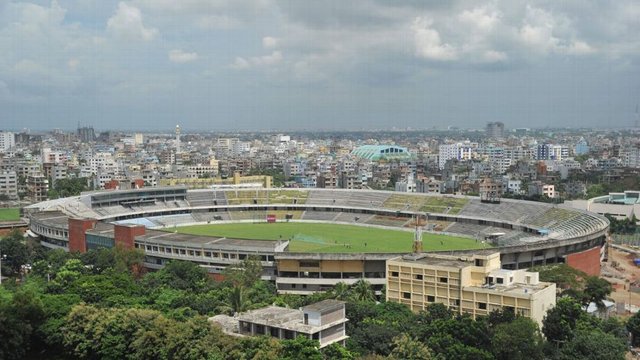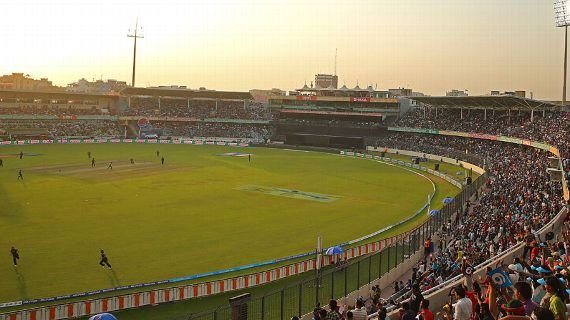Mirpur stadium wins the race to 100

The Sri Lanka-Zimbabwe game on January 17 will be the 100th ODI held at the Shere Bangla National Stadium. Compared to the five other stadiums that have reached this landmark, Mirpur has taken the shortest time - a little over 11 years. This level of use as an international venue indicates what the place has meant to Bangladesh cricket. But the occasion seems to be slipping under the radar of the BCB. A day out from the start of the tri-series, there are no celebrations planned, as is usually the case with every big and small milestone in Bangladesh cricket.
Mirpur is more than just a cricket venue, and it is a story onto itself, having smoothly taken over from the more celebrated Bangabandhu National Stadium (BNS), which used to be the spiritual home of Bangladesh cricket just 15 years ago.
Mirpur may lack for history but that only works in its favour. It is the symbol of modernity and that begins with the number of Bangladesh wins in this venue, especially against higher-ranked opponents. It was here that they beat New Zealand 4-0 in 2010, where they reached the final of the 2012 Asia Cup, where they picked up ODI series wins over India, Pakistan and South Africa in 2015. Mirpur is the site of Test wins over England and Australia.
It is also the one-stop shop for every cricketing need. The Shere Bangla houses houses two practice facilities and the board headquarters, apart from the high-class stadium that hardly anyone has complained about (apart from the ICCrecently when they rated the outfield "poor"). Players and coaches are fond of the ground and the big dressing rooms; fans love the cleaner, more accessible stands while the journalists laud the press box.
It is Bangladesh's home ground in every sense of the word, and it turns into a daunting fortress when the stands are packed, the pitch is turning and Bangladesh are winning. They rarely won at the Bangabandhu, though it wasn't the stadium's fault. Bangladesh were an up-and-coming Associate nation between 1988 and 2000, and in the five years that cricket was played at BNS, they were a struggling Test side. In fact, their most memorable wins here was during the last few months the stadium was being used. Beating India in December 2004. Beating Zimbabwe in 2005.

Nevertheless, it is hard to let go of what the BNS meant to the Bangladeshi psyche, especially to those who lived through the East Pakistan days. The Dacca Stadium, as it was known since being built in the early 1950s, hosted Pakistan's first home Test, and six more till 1969. It was the place to be, especially if you were a sports fan. Many from that generation have stories of their fathers taking them to the stadium for the first time, or them saving up lunch money from school to steal a glimpse of the day's heroes - be it the intermittent Test match or a league game.
The lore and lure of the BNS remained even after Bangladesh's independence when a young nation played most of its sport in and around this venue. From 1977 till 2000, every important match and tournament - international or domestic - was held at Bangabandhu.
As cricket's schedule got busier, and especially when the game gained tremendous popularity in Bangladesh in 1997, it started to clash with the football federation. It used to be summer for football, winter for cricket but with more cricket tournaments being hosted, particularly after Bangladesh gained Test status in 2000, it was clear that one stadium couldn't house two sports like they did in Australia. More to the point, two sporting bodies couldn't coexist.
The government finally intervened in mid-2004 when they asked the BCB to make arrangements at the Shere Bangla National Stadium in the city's populous northern locality of Mirpur. It held some league football matches but was known for violent after-match incidents and some athletic meets.
There was much mistrust among cricket officials, players and fans when the move was being made. Some thought it was jealousy on the part of the football bosses while others doubted whether cricket had any friends in the government. But within a year or two as cricket gained more popularity, they forgot about the BNS (though in 2009, some BCB directors made a push for some 2011 World Cup matches. Eventually, the opening ceremony was held there).
The move was highly beneficial to everyone concerned, more so for Mirpur. When the government started development work for the 2011 World Cup, there was a lot of improvement in infrastructure spanning at least 10km around the stadium. It gave the area a much-needed facelift, and through big cricket events and wins, Mirpur has entered cricket's consciousness for good. It has provided a much-needed domicile for all representative teams (senior, A team, High Performance, women's and age-group teams) under the BCB. No longer does the board have to send teams to far-flung BKSP in Savar for training camps.
For many generations, watching cricket at the BNS, eating a hefty meal in Islamia restaurant and braving the Gulistan traffic were the cool things to do for fans. Now, they watch Bangladesh play at the Shere Bangla, have a plate of kabab or khichuri in Purnima, and then find their way home with phones full of photos of cool Mirpur.
tnx for good update